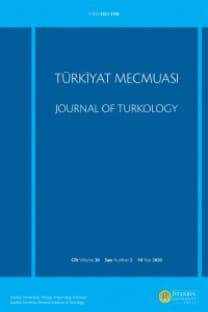Cambridge Üniversitesini Padişaha Nasıl Anlatmalı? 1835 Tarihli Seyyâhnâme’de Avrupa Üniversite ve Eğitim Sistemine Dair Kelime, İfade ve Tanımlama Yapıları
Seyyâhnâme, Mehmed Emin Paşa, İngiltere ve Londra 1835, Cambridge Üniversitesi, Tanzimat Türkçesi, Türk Eğitimbilim Terminolojisi, Üniversite Tarihi
How to Explain the University of Cambridge to the Sultan? Words, Expressions, and Definition Structures on the European University and Education System Observed in the Book of Traveler “Seyyâhnâme” Dated 1835
The Book of Traveler “Seyyâhnâme, ” Mehmed Emin Paşa, Britain and London 1835, Cambridge University, Tanzimat Turkish, the Turkish Terminology of Education, History of University,
___
- Ayalon, Ami. Language and Change in the Arab Middle East: The Evolution of Modern Arabic Political Discourse, New York: Oxford University Press, 1987.
- Buluç, Sadettin. “Türkçe Yazma İki Seyahâtnâme”, IX. Türk Tarih Kongresi, Ankara 21-25 Eylül 1981, Kongreye Sunulan Bildiriler, cilt 3, Ankara: Türk Tarih Kurumu, 1989: 1505-1513.
- Dönmez, Ahmet. Osmanlı-İngiliz İlişkileri: Diplomasi ve Reform (1833–1841). (Selçuk Üniversitesi Sosyal Bilimler Enstitüsü Tarih Ana Bilim Dalı Yakınçağ Tarihi Bilim Dalı, Yayımlanmamış Doktora Tezi, 2013.)
- Günergün, Feza. “Eski Fransız ve Metre Osmanlı Ölçü ve Tartılarının Sistemlerindeki Eşdeğerleri: İlk Karşılaştırmalar ve Çevirme Cetvelleri”, Osmanlı Bilimi Araştırmaları, Sayı 2 (1998): 23-68.
- Karabıçak, Yusuf Ziya. “Why Would We Limberte?”, Liberté in the Ottoman Empire, 1792-1798”, Turcica 51 (2020): 219-253.
- Mehmed Es’ad. Mirât-ı Mekteb-i Harbiye, İstanbul: Artin Asaduryan Şirket-i Mürettibiye Matbaası, 1310/1892-93.
- Mehmed Süreyya. Sicill-i Osmanî, Osmanlı Ünlüleri, Cilt II, Hazırlayanlar: Nuri Akbayar ve Seyit Ali Kahraman, İstanbul: Tarih Vakfı Yurt Yayınları, 1996.
- Polat, Atilla. “Mekteb-i Harbiye Nazırlarından Matematikçi Mehmed Emin Paşa’nın Biyografisine Giriş”, Osmanlı Bilimi Araştırmaları 20/2 (2019): 59-74.
- Tosun, Ali Rıza. “İlk Kapsamlı Türkçe Mühendislik Kitabı Mecmûât El-Mühendisîn’in Ele Aldığı Konular ve Niteliği Hakkında Bir Değerlendirme”, Belleten 74/270 (2010): 517-530.
- Turan, Fikret. “Forming the Modern Diction of Tanzimat Turkish: Words and Expressions of Modernity in Seyāhatnāme-i Londra”, Turkic Languages, 11/2 (2007): 159-181.
- Yayın Aralığı: 2
- Başlangıç: 1925
- Yayıncı: İstanbul Üniversitesi Türkiyat Araştırmaları Enstitüsü
Tanzîmât Döneminde Osmanlı Hariciyesinde Ataşelik Memuriyetinin Teşekkülü
Gelibolulu Mustafa Âlîˈde Aitlik ve Kimlik Kavramları: Türk, Türkmen ve Rûmî
Mütareke Döneminde Prens Sabahattin Yanlısı Bir Siyasi Oluşum: Sulh ve Selâmet-i Osmâniyye Fırkası
Türk Musikisi Kaynaklarında “Bülbül” İsmiyle Anılan Peşrevler
Sezer Özyaşamış Şakar’ın “Eski Türkiye Türkçesinin Deyimler Sözlüğü” adlı eserinin değerlendirilmesi
Kayıp Çerkesya ve Bulunan Çerkesler: Osmanlı İmparatorluğu'na Kafkas Göçü
Teoriden Edebî Metne Mustafa Miyasoğlu’nun Gelenek Algısı
Murat Yusuf ÖNEM, Selim SOMUNCU
Yemen’i Payitaht’a Bağlamak: Yemen Vilayeti Telgraf Şebekesi ve Bağlantı Hatları
Eski Osmanlı Topraklarında Mülkiyet Davaları: Selanik 1917-1922
